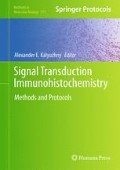Abstract
Simultaneous detection of multiple tissue antigens is one of the most frequently used immunohistochemical (IHC) techniques. In order to avoid cross-reactivity of each secondary antibody with multiple primary antibodies when doing either dual- or triple-labeling immunofluorescence, it is necessary to use primary antibodies raised in different host species such as mouse, rabbit, and goat. However, in many cases, suitable primary antibodies raised in different species are unavailable. We have developed a novel technique for triple-labeling immunofluorescence that can be used with primary antibodies derived from a single host source. This technique includes modification of one primary antibody with biotin (ChromaLink™ Biotin) and a second primary antibody with DIG (ChromaLink™ Digoxigenin). For IHC staining, cells or tissue sections are incubated first with unconjugated primary antibody against the first target protein followed by detection with antiprimary secondary antibody conjugated to NorthernLights™ NL-637 tag (fluorescence in the far-red spectral region). Subsequently, the same tissue sections are incubated with a mixture of same species biotin-labeled primary antibody (against the second target protein) and DIG-labeled primary antibody (against the third target protein) followed by detection using a mixture of Streptavidin NorthernLights™ NL-493 tag (green fluorescence) and anti-DIG secondary antibody conjugated to a Rhodamine Red X™ tag (red fluorescence). This technique provides good spectral separation of colors depicting different antigens of interest while avoiding cross-reactivity between irrelevant primary and secondary antibodies. In addition, this multiplexed IHC technique provides significant convenience to researchers who have only primary antibodies raised in the same host species at their disposal.
Access this chapter
Tax calculation will be finalised at checkout
Purchases are for personal use only
References
Kalyuzhny, A.E. (2009) The dark side of the immunohistochemical moon: industry. J. Histochem. Cytochem. 57, 1099–1101.
Wessendorf, M.W., Appel, N.M., Molitor, T.W., and Elde, R.P. (1990) A method for immunofluorescent demonstration of three coexisting neurotransmitters in rat brain and spinal cord, using the fluorophores fluorescein, lissamine rhodamine, and 7-amino-4-methylcoumarin-3-acetic acid. J. Histochem. Cytochem. 38, 1859–1877.
Staines, W.A., Meister, B., Melander, T., Nagy, J.I., and Hökfelt, T. (1988) Three-color immunofluorescence histochemistry allowing triple labeling within a single section. J. Histochem. Cytochem. 36,145–151.
Wang, B.L., and Larsson, L.I. (1985) Simultaneous demonstration of multiple antigens by indirect immunofluorescence or immunogold staining. Novel light and electron microscopical double and triple staining method employing primary antibodies from the same species. Histochemistry. 83, 47–56.
Van der Loos, C.M., Das, P.K., Van den Oord, J.J., and Houthoff, H.J. (1989) Multiple immunoenzyme staining techniques. Use of fluoresceinated, biotinylated and unlabelled monoclonal antibodies. J. Immunol. Methods. 117, 45–52.
Cavet, M.E., Lehoux, S., and Berk, B.C. (2003) 14-3-3beta is a p90 ribosomal S6 kinase (RSK) isoform 1-binding protein that negatively regulates RSK kinase activity. J. Biol. Chem. 278, 18376–1883.
Casar, B., Sanz-Moreno, V., Yazicioglu, M.N., Rodríguez, J., Berciano, M.T., Lafarga, M., et al., (2007) Mxi2 promotes stimulus-independent ERK nuclear translocation. EMBO J. 26, 635–646.
Takahashi, M., Buma, Y., Iwamoto, T., Inaguma, Y., Ikeda, H., and Hiai, H. (1988) Cloning and expression of the ret proto-oncogene encoding a tyrosine kinase with two potential transmembrane domains. Oncogene. 3, 571–578.
Brizzee, K.R., Ordy, J.M., and Kaack. B. (1974) Early appearance and regional differences in intraneuronal and extraneuronal lipofuscin accumulation with age in the brain of a nonhuman primate (Macaca mulatta). J. Gerontol. 29, 366–381.
Dowson, J.H., Armstrong, D., Koppang, N., Lake, B.D., and Jolly, R.D. (1982) Autofluorescence emission spectra of neuronal lipopigment in animal and human ceroidoses (ceroid-lipofuscinoses). Acta Neuropathol. 58, 152–156.
Schnell, S.A., Staines, W.A., and Wessendorf, M.W. (1999) Reduction of lipofuscin-like autofluorescence in fluorescently labeled tissue. J. Histochem. Cytochem. 47, 719–730.
Author information
Authors and Affiliations
Corresponding author
Editor information
Editors and Affiliations
Rights and permissions
Copyright information
© 2011 Springer Science+Business Media, LLC
About this protocol
Cite this protocol
Frisch, J. et al. (2011). Novel Multicolor Immunofluorescence Technique Using Primary Antibodies Raised in the Same Host Species. In: Kalyuzhny, A. (eds) Signal Transduction Immunohistochemistry. Methods in Molecular Biology, vol 717. Humana Press. https://doi.org/10.1007/978-1-61779-024-9_13
Download citation
DOI: https://doi.org/10.1007/978-1-61779-024-9_13
Published:
Publisher Name: Humana Press
Print ISBN: 978-1-61779-023-2
Online ISBN: 978-1-61779-024-9
eBook Packages: Springer Protocols

